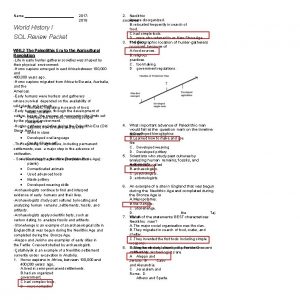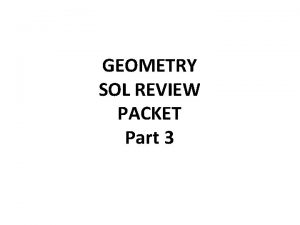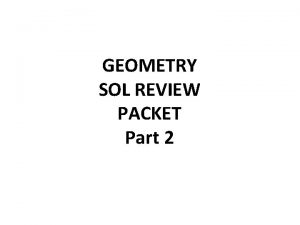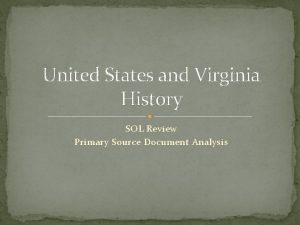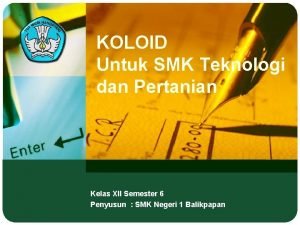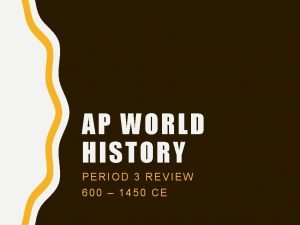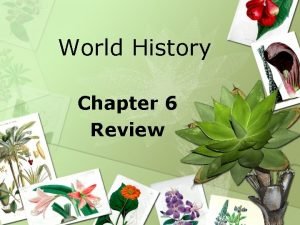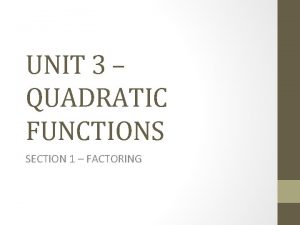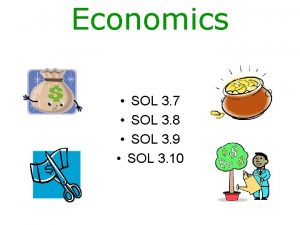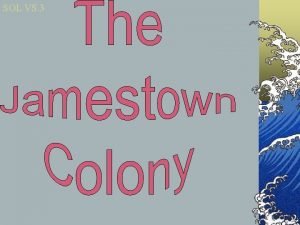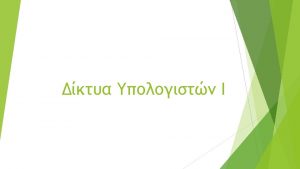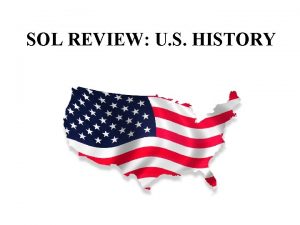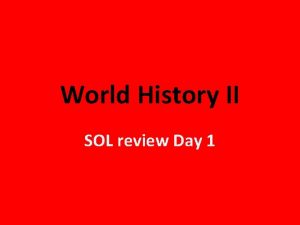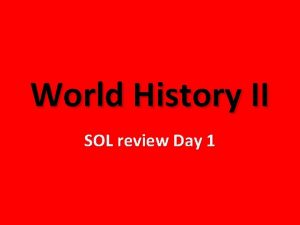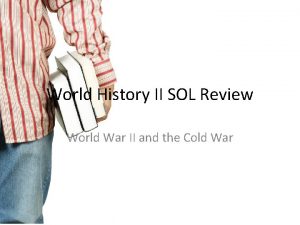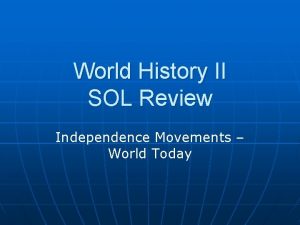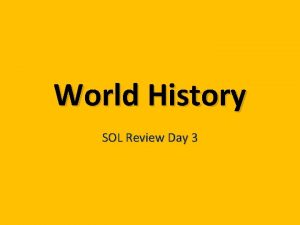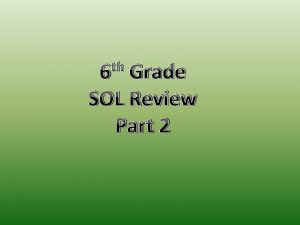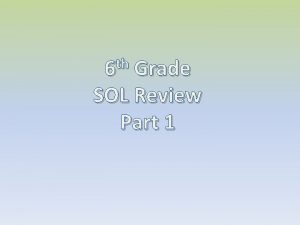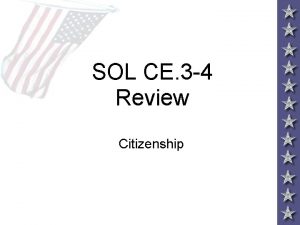Name 20172018 World History I SOL Review Packet


























- Slides: 26

Name 20172018 World History I SOL Review Packet WHI. 2 The Paleolithic Era to the Agricultural Revolution -Life in early hunter-gatherer societies was shaped by their physical environment. -Homo sapiens emerged in east Africa between 100, 000 and 400, 000 years ago. -Homo sapiens migrated from Africa to Eurasia, Australia, and the Americas. -Early humans were hunters and gatherers whose survival depended on the availability of wild plants and animals. Nomadic, migrating in search of food, -Early human water, societies, shelter through the development of culture, the process of overcoming the limits set began Invented the first tools, including simple by the physical environment. weapons -Hunter-gatherer societies during Paleolithic Era (Old Learned how to make andthe use fire Stone Age): Lived in clans Developed oral language Createdof“cave art” -The beginning agriculture, including permanent settlements, was a major step in the advance of civilization. - Societies during the Neolithic (domesticated Era (New Stone Age): Developed agriculture plants) Domesticated animals Used advanced tools Made pottery Developed weaving skills -Archaeologists continue to find and interpret evidence of early humans and their lives. -Archaeologists study past cultures by locating and analyzing human remains, settlements, fossils, and artifacts. -Archaeologists apply scientific tests, such as carbon dating, to analyze fossils and artifacts. -Stonehenge is an example of an archaeological site in England that was begun during the Neolithic Age and completed during the Bronze Age. -Aleppo and Jericho are examples of early cities in the Fertile Crescent studied by archaeologists. -Çatalhöyük is an example of a Neolithic settlement currently under excavation in Anatolia. 1. Homo sapiens in Africa, between 100, 000 and 400, 000 years ago, A. lived in semi-permanent settlements. B. had an organized government. C. had complex tools. D were nomadic. 2. Neolithic A. were disorganized. societies B. relocated frequently in search of food. C. had simple tools. D were also referred to as New Stone Age societies. 3. The geographic location of hunter-gatherers occurred because of A. food sources. B. religious practices. C. tool making. D government regulations. 4. What important advance of Paleolithic man would fall at the question mark on the timeline A. Developed hieroglyphics above? B. Learned how to make and use fire C. Developed weaving D. Developed pottery 5. Scientists who study past cultures by analyzing human remains, fossils, and A. geologists. artifacts are called B. archaeologists. C. psychologists. D. entomologists. 6. An example of a site in England that was begun during the Neolithic Age and completed during the Bronze Age is A. Mesopotamia. B. the Ganges. C. Stonehenge. D. the Taj Mahal. of the statements BEST characterizes 7. Which Neolithic man? A. The major social organization was the clan. B. They migrated in search of food, water, and shelter. C. They invented the first tools including simple weapons. D. They farmed and cities developed permanent 8. Examples of early in the Fertile Crescent studied by archeologists are settlements. A Aleppo and Jericho. B Cairo and Alexandria. C Jerusalem and Rome. D Athens and Sparta.

WHI. 3 Ancient River Valley Civilizations -During the New Stone Age, permanent settlements appeared in river valleys and around the Fertile Crescent. -River valleys provided water and rich soil for crops as well as protection from invasion. -Earliest river valley civilizations (about 3500 Mesopotamian civilization: Tigris andto 500 B. C. [B. C. E]): Euphrates River Valleys (Southwest Asia) Egyptian civilization: Nile River Valley and Nile Delta (Africa) Indian civilization: Indus River Valley (South Asia) Chinese civilization: Huang (East -These river valleys offered rich soil He and. Valley irrigation water Asia) for agriculture, and they tended to be in locations easily protected from invasion by nomadic peoples. - Other early civilizations (about 2000 to 500 B. C. [B. C. E. ]): Hebrews settled between the Mediterranean Sea and the Jordan River Valley (part of Fertile Crescent in Southwest Asia). Phoenicians settled along the Mediterranean coast (part of Fertile Crescent in Southwest Asia). Nubia (Kush) was located on the upper (southern) River (Africa). -River valleys were Nile the “Cradles of Civilization”. -Early civilizations made major contributions to social, political, and economic progress. - Social patterns of ancient river valley civilizations: Hereditary rulers: Dynasties of kings, pharaohs class slavery was -Political. Rigid patterns ofsystem ancientwhere river valley accepted civilizations: World’s first states (i. e. , city-states, kingdoms, empires) Centralized government, often based on religious authority Writtenoflaw codes (e. g. , Tenof ancient -Development economic patterns Commandments, Code of Hammurabi) river valley civilizations: Use of metal (e. g. , bronze, iron) tools and weapons Increasing agricultural surplus: Better tools, plows, irrigation Increasing trade along rivers and by sea (Phoenicians) Development of the world’s first cities Development theofpractice slavery within -Religion was a major of part life in allofearly most cultures in the ancient world, taking civilizations. forms -Religious traditions that practiced developed ancient various Polytheism was byinmost early civilizations: civilizations. Monotheism was practiced by the Hebrews. -The monotheism of Abraham became the foundation of Judaism, Christianity, and Islam—religions that changed the world. The Hebrews were the first to become monotheists. -The origins of Judaism include: Abraham- founder Moses- led Hebrew Exodus out of Egypt, received the Ten Commandments Jerusalem- political and religious capital -The beliefs, traditions, and customs of Judaism include: Belief in one God (monotheism) Torah, which contains written records and beliefs of Jews Ten Commandments, which state moral and religious conduct -The spread of Judaism includes: Exile- Jews forced out of homeland Diaspora- “scattering” of Jews due to exile -Language and writing were important cultural innovations. -The forms of language and writing Pictograms: Earliest writtenthat existed in early civilizations: symbols Hieroglyphics: Egypt Cuneiform: Sumer Alphabet: Phoenicia 1. Which one of the following was a river valley civilization in Africa about 3500 to 500 B. C. (AB. C. E. )? Mesopota mia B Phoenicia C. Hindu 2. The Kush most important reason man’s earliest D. Egypt civilizations began in river valleys was A. were used for valleys… extensive trade. because these B. offered abundant wildlife for food. C. offered rich soil for agriculture. 3. One of the first written codes of law D provided transportation for nomadic peoples. Vedas. was. A. the. B. Code of Hammurabi. C. Eightfold Path to Enlightenment. D. hieroglyphics. 4. The origin of Judaism can be A. Abraham. traced to… B. Mohammed. C. Asoka. D Gautama. 5. The Jews first A. in the Tigris and Euphrates river valleys. settled B. between the Mediterranean Sea and the Jordan River Valley. C along the upper (southern) Nile River Valley. D along the Mediterranean coast.

6. The Hebrews were sent into exile from their homeland then scattered. This was called the. A. Exodus B. Great Migration C. Spread ID. am. Diaspora the Lord your God, who brought you out of the land of Egypt, out of the house of bondage. You shall have no other gods before Me. 7. The words above set the Jews apart from all other peoples of the Fertile Crescent because they demonstrate the Jews’ A belief in written laws. B belief in strong government. C belief in more than one god. 8. D Which beliefcivilization in one god. is given credit for the alphabet? A Sumerian s B Phoenicia ns C WHI. 4 Cultures of Persia, India, and China -Persia, Babylonia built on earlier Central Asian and Mesopotamian ns D civilizations, Hebrews developed the largest empire in the world. -Zoroastrianism was the main Persian religion, although other religions were tolerated. -Characteristics of the Persian Empire: Tolerance of conquered peoples Development of imperial bureaucracy Construction of road system. Royal o Road Religion of Persia Practice of Zoroastrianism o Belief in two opposing forces in the universe -Classical Indian civilization began in the Indus River Valley, spread to the Ganges River Valley, and then spread through the Indian subcontinent. This spread continued with little interruption because of the geographic location. -Physical barriers such as the Himalayas, the Hindu Kush, and the Indian Ocean made invasion of India more difficult. -Mountain passes in the Hindu Kush, such as the Khyber Pass, provided migration routes into the Indian subcontinent. -The Indus and Ganges were the important rivers in the Indian subcontinent. -The Indo-Aryan people migrated into the area, creating -Important cities for the Indus River Valley civilization: a structured (caste system) and blending their Harappa andsociety Mohenjo-Daro beliefs with those of the indigenous people. -The impact of the Aryans (Indo-Aryans) on India included: Aryan migration into India Assertion of Aryan dominance over Harappan culture Caste system, which influenced all social interactions and choices of occupations -Accomplishments of the Mauryan Empire: Asoka- Mauryan ruler Continued political unification of much of India Contributions: Spread of Buddhism, free hospitals, veterinary clinics, good roads -Accomplishments of the Gupta Empire: Golden Age of classical Indian culture Contributions: Mathematics (concept of zero), medical advances (setting bones), astronomy (concept of a round Earth), new textiles, literature -During the Golden Age of classical Indian culture, Indian people made significant contributions to world civilization. -Hinduism was an important contribution of classical India. -Hinduism influenced Indian society and culture and is still practiced in India today. -Aspects of Hinduism: Caste system (use CORKS to remember!) One God, many forms Reincarnation: Rebirth based upon karma Karma: Knowledge that all thoughts and actions result in future consequences Sacred writings: Vedas and Upanishads No single founder Spread along major trade routes -Buddhism was founded by Siddhartha Gautama in a part of India that is in present-day Nepal. -Buddhism became a major faith when Asoka sent missionaries throughout Asia. -Aspects of Buddhism: (remember numbers 4 & 8!) Founder: Siddhartha Gautama (Buddha) Four Noble Truths- suffering is caused by ignorance and worldly desires Eightfold Path to Enlightenment-steps to overcome desires and end suffering -Asoka’s missionaries and their writings spread Buddhism from India to China and other parts of Asia. -Classical China was centered on the Huang He (Yellow River) and was geographically isolated. -Invaders entered China from the north. The Great Wall was built for China’s protection. - Chinese culture began around 1500 B. C. (B. C. E. ). -Of Chinese contributions to civilization, Confucianism and Taoism are among the most noted. -Migratory invaders raided Chinese settlements from the north. -Qin Shi Huangdi built the Great Wall as a line of defense against invasions.

-China was governed by a succession of ruling families called dynasties. -Chinese rulers were considered divine, but they served under a Mandate of Heaven only as long as their rule was just. -The Silk Road facilitated trade and contact between China and other cultures as far away as Rome. -Contributions of classical China to world civilization include: Civil service system Paper Porcelain Silk -The impact of Confucianism in forming the social order in China included: (use BRACE to remember!) Belief that humans are good, not bad Respect for elders Ancestor worship Code of politeness (still used in Chinese society today) Emphasis on education -The impact of Taoism in forming Chinese culture and values included: (remember HSH!) Humility Simple life and inner peace Harmony with nature - Yin and Yang represented opposites for Confucianism and Taoism. -Chinese forms of Buddhism spread throughout Asia. 1. Which of the following is a characteristic of A Abuse of conquered Persian rulers? peoples B Primitive transportation C. Development of imperial bureaucracy D. characteristic Hinduism as aofreligion 2. A the Aryan society of A. was a rigid caste system. India B. development of a sophisticated alphabet. C. Buddhism as a religion. D. tolerance of conquered peoples. 3. A belief in reincarnation, karma, many forms of one major deity, and a caste system are characteristics of which of the following A. Hinduism religions? B. Buddhism C. Judaism D. Zoroastriani sm 4. The following is a sacred writing of Hinduism: A Ten Commandments B New Testament C. Upanishads & Vedas D. Koran 5. Which of the following civilizations contributed a civil service system, paper, porcelain, and silk? A. Indus B. Gupta C. China D. Egypt 6. Zoroastrianism existed in which A. Phoenici civilization? an B. Persian C. Egyptian D. Assyrian 7. During the Gupta Empire, numerous contributions were made in the areas of A. technology and literature B. mathematics, medicine, and literature C. music and literature D. music, literature, and 8. The founder of mathematics A. Asoka. Buddhism was B. Siddhartha Gautama. C. Shi Huangdi. D. Chandragupta Maurya. 9. All of the following relate to Confucianism except A ancestor worship. B respect for elders. C belief in one 10. China’s the right to god. D leaders codereceived of rulepoliteness. by A Mandate of Heaven. B an elder chieftain. C. a high priest. D. military leaders. WHI. 5 Ancient Greece -The physical geography of the Aegean basin shaped the economic, social, and political development of Greek civilization. -The expansion of Greek civilization through trade and colonization led to the spread of Hellenic culture across the Mediterranean and Black seas. -Locations and places, such as the mountains, seas, islands, harbors, peninsulas, and straits of the Aegean basin, shaped Greek economic, social, and political development and. Sea patterns of trade and Aegean colonization, including: Balkan and Peloponnesus peninsula, Europe, Asia Minor Mediterranean Sea Black Sea, Dardanelles Athens, Sparta, Troy Macedonia

-The economic and social development of Greece included: Agriculture (limited arable land) Commerce (trade) and the spread of Hellenic culture Shift from barter to money economy (coins) - The political development of Greece included: Mountainous terrain both helped and hindered the development of city-states Greek cities were designed to promote civic and commercial life. Colonization was prompted by overpopulation and the search for arable land. - Greek mythology was based on a polytheistic religion that was integral to the culture, politics, and art in ancient Greece. – Many of Western civilization’s symbols, metaphors, words, and idealized images come from ancient Greek mythology. - Mythology helped the early Greek civilization explain Based on polytheistic religion the natural worldexplanations and the human condition, including: Offered of natural phenomena, human qualities, and life events - Greek gods and goddesses impacted later civilizations and the contemporary world, including the deities: Zeus (king, sky, weather), Hera (queen, marriage), Apollo (light, music, prophecy, healing), Artemis (hunting), Athena (wisdom, war craft), Aphrodite (love, beauty) Symbols and images in Western literature, art, and architecture -Classical Athens developed the most democratic system of government the world had ever seen, although not everyone could participate in decision making. It became a foundation of modern democracies. -The contrasting philosophies of government divided the Greek city- states of Athens (democracy) and Sparta (oligarchy). Citizens (free adult males) had political -The social structure citizenship in Greek polis rights and theand responsibility ofthe civic included: participation in government. Women and foreigners had no political rights. Slaves had no political rights. -Athens Stages in evolution of Athenian government: Monarchy, aristocracy, tyranny, democracy Tyrants who worked for reform: Draco, Solon Origin of democratic principles: Direct democracy, public debate, duties of the citizen -Sparta Oligarchy (rule by a small group) Rigid social structure Militaristic and aggressive society -The Greeks defeated the Persian Empire and preserved their political independence. - Competition between Sparta and Athens for control of Greece helped cause the Peloponnesian War. -The Persian Wars from 499 to 449 B. C. (B. C. E. ) was important to the development of Greek culture, including: Persian Wars united Athens and Sparta against the Persian Empire. Athenian victories over the Persians at Marathon and Salamis left Greeks in control of the Aegean Sea. Athens preserved its independence and continued innovations in government and culture. -The Peloponnesian War (431– 404 B. C. (B. C. E. ) was important because: Caused in part by competition for control of the Greek world: Athens and the Delian League versus Sparta and the Peloponnesian League Resulted in the slowing of cultural advance and the weakening of political power - Athenian culture during the classical era became one of the foundation stones of Western civilization. -The leadership of Pericles and its importance to the development of Age Athenian life and Greekoccurring culture Golden of Pericles (mostly included: between the Persian and the Peloponnesian wars) Pericles extended democracy; most adult males had an equal voice. Pericles had Athens rebuilt after destruction in Persian Wars; the Parthenon is an example of this reconstruction. - Contributions of Greek culture to Western civilization include: Drama: Aeschylus, Sophocles (Oedipus Rex) Poetry: Homer (Iliad and Odyssey) History: Herodotus (father of history), Thucydides Sculpture: Phidias (Parthenon) Architecture: Types of columns, including Doric (Parthenon), Ionian, and Corinthian Science: Archimedes, Hippocrates (medicine)conquest of Greece followed the -The Macedonian Mathematics: Euclid (geometry), weakening of Greek defenses during the Pythagoras Peloponnesian War. Philosophy: Socrates, (in - Alexander the Great adopted Plato, Greek. Aristotle culture and order SPA) spread Hellenistic influences throughout his vast empire. -The Macedonian conquest and the contributions of Phillip II, King of Macedon Alexander the Great to the spread of Hellenistic culture include: Conquered most of Greece

-Alexander the Great Established an empire from Greece to Egypt and the margins of India Extended Greek cultural influences - Hellenistic Age: Blend of Greek and oriental elements Spread of Hellenistic culture through trade 1. The Greek civilization was located on which of the following bodies of water? A. Red Sea B. Nile River C. Indus River D. Aegean Sea 2. Greek civilization was A polytheistic characterized by religion based on mythology. B harmony with nature. C. ancestor worship. D. caste systems in religious law. 3. An important economic development in ancient A. anwas increase in trade with Western Europe. Greece B. a shift from a money economy to a barter economy. C. a shift from a barter economy to a money economy. 4. D. Thethe earliest systemofofsea routes. use of democratic land routes instead government was developed in A. classical Athens. B. Sparta. C. Egypt. D. India. 5. The structure shown to the right was built by which A. Pericles famous Greek? B. Phidias C. Archimedes D. Euclid 6. What is the correct order of the evolution of Rule by: democracy in Athens? King A Monarchy, aristocracy, tyranny, 1. democracy 2. Rich B Aristocracy, monarchy, tyranny, 3. Strict ruler democracy 4. People C Tyranny, aristocracy, monarchy, 7. A government that is an oligarchy is democracy A representative rule of aristocracy, characterized by D a. Monarchy, tyranny, government. B rule by a small democracy group. C. rule by a dictator. D. rule by a monarch. 8. How did the results of the Persian Wars impact Western Civilization? A. Persian influence increases greatly in the West. B. Athens preserved its independence and continued innovations in government and culture. C. Persian and Greek religions merged and spread throughout the Mediterranean and beyond. D. Cultural advancements slowed and the political of 9. Whatpower key event united the Greek city-states to the Greeks weakened. a greater degree than they had been before? A The establishment of a constitution by Solon B The development of democracy in Athens C. The formation of the Delian League D. The fighting of the Persian Wars 10. The significance of the Persian Wars was that A. Athens and Sparta united against the Persian Empire. B. Greece emerged as the world’s most powerful government. C. the cultural advancements of Greek civilization slowed. D. Ancient Greek democracy WHI. 6 Rome was extended throughout the Mediterranean -The city of Rome, with area. its central location on the Italian peninsula, was able to extend its influence over the entire Mediterranean basin. -The Italian peninsula was protected by the sea and the arc of the Alps mountains. -Geography was important to the economic, social, and political development of ancient Rome: Centrally located in the Mediterranean including: basin and distant from eastern Mediterranean powers Italian Peninsula Alps: Protection Mediterranean Sea: Protection, sea-borne - Romancommerce mythology, like Greek mythology, was based upon a polytheistic religion that was integral to culture, politics, and art. -Many of Western civilization’s symbols, metaphors, words, and idealized images come from ancient Roman mythology. Based on the Greek polytheistic religion -Roman mythology: of natural phenomena, human Explanations qualities, and life events Gods and goddesses included: Jupiter (king, sky, weather), Juno (queen, marriage), Apollo (light, music, prophecy, healing), Diana (hunting), Minerva (wisdom, war craft), and Venus (love, beauty) Symbols and images in literature, art, and architecture - Although women, most aliens (non-Romans living in the Republic), and slaves were excluded from the governing process, the Roman Republic made major strides in the development of representative democracy, which became a foundation of modern democracy.

-The social structure in the Roman Republic included: Patricians: Powerful nobility (few in number) Plebeians: Majority of population Slaves: Not based on race -The citizenship of the Roman Republic included: Patrician and plebeian men Selected foreigners Rights and responsibilities of citizenship (e. g. , taxes, military service) -The features of democracy in the Roman Republic included: Representative democracy Assemblies (legislative) The Senate (legislative) Consuls (executive) Laws of Rome codified as Twelve Tables -After the victory over Carthage in the Punic Wars, Rome was able, over the next 100 years, to dominate the Mediterranean basin, leading to the diffusion of Roman culture. -The Punic Wars between Rome and Carthage from 264 to 146 (B. C. E. ): B. C. Rome and Carthage were in competition for trade. Hannibal invaded the Italian Peninsula. Three wars resulted in Roman victory, the destruction Carthage, andand expanded -The evolution of theof. Roman Empire Romantrade and wealth culture to: for Rome. spread Mediterranean basin (Africa, Asia, Europe, including the Hellenistic world of the Eastern Mediterranean) Western Europe (Gaul, British Isles) -The Roman Republic, in the face of changing social and economic conditions, succumbed to civil war, and was replaced by an imperial regime, the Roman Empire. -The causes for the decline of the Roman Republic included: Spread of slavery in the agricultural system Migration of small farmers into cities and unemployment Civil war over the power of Julius Caesar Devaluation of Roman currency; inflation -The origin and evolution of Imperial Rome included: First triumvirate Julius Caesar: Seizure of power, assassination Augustus Caesar: Civil war, defeat of Marc Anthony, Rome’s first emperor Empire: Unified and enlarged, using imperial authority and the military Failure to provide for peaceful succession of Emperors -Augustus Caesar established the Roman Empire by instituting civil service, rule by law, a common coinage, and secure travel and trade throughout the Empire. -Following Augustus Caesar, the Roman Empire enjoyed 200 years of peace and prosperity known as the Pax Romana. -Pax Romana and its economic, social, and political impact: Two centuries of peace and prosperity under imperial rule Expansion and solidification of the Roman Empire, particularly in the Near East Economic impact of the Pax Romanaestablished uniform system of money, which helped to expand trade, guaranteed safe travel and trade on Roman roads, promoted prosperity and stability Social impact of the Pax Romana- returned stability to social classes, increased emphasis on the family Political of the Pax Romana-throughout created a the -The followers ofimpact Jesus spread Christianity civil service, developed a uniform rule of law Roman Empire, bringing it into conflict with Roman polytheism and eventually changing Western civilization. -The origins of Christianity within the Roman Empire: : Had its roots in Judaism Was led by Jesus of Nazareth, who was proclaimed the Messiah Conflicted with polytheistic beliefs of the Roman Empire and customs of -The beliefs, traditions, Christianity included: Monotheism Jesus as both Son and incarnation of God Life after death New Testament, containing accounts of the life and teachings of Jesus, as well as writings of early Christians Christian doctrines established by early church -The spread of Christianity councils included: Popularity of the message Early martyrs inspired others Carried by the Apostles, including Paul, throughout the Roman Empire -As the Roman Empire declined in the West, the Church of Rome grew in importance, followers, and influence. -The impact of the Church of Rome in the late Roman included: Empire The Emperor Constantine converted to Christianity and made it legal. Christianity later became the official state religion. The Church became a source of moral authority. Loyalty to the Church became more important than loyalty to the Emperor. The Church became the main unifying force of Western Europe. -Conquests and trade spread Roman cultural and technological achievements throughout the Empire. -Western civilization was influenced by the cultural achievements of Rome.

-The contributions of ancient Rome included: Art and architecture: Pantheon, Colosseum, Forum Technology: Roads, aqueducts, Roman arches Science: Achievements of Ptolemy (astronomy) Medicine: Emphasis on public health (public baths, public water systems, medical schools) Language: Latin, Romance languages Literature: Virgil’s Aeneid Religion: Roman mythology; adoption of Christianity as the imperial religion Law: The principle of “innocent until proven guilty” (from the Twelve Tables) -Over a 300 -year period, the western part of the Roman Empire steadily declined because of internal and external problems. -The causes for the decline of the Western Roman Geographic size: Difficulty of defense and Empire included: administration Economy: The cost of defense, and devaluation of Roman currency Military: Army membership starting to include non -Romans, resulting in decline of discipline Moral decay: People’s loss of faith in Rome and the family Political problems: Civil conflict weak -The division (Emperor Diocletion) of theand Roman administration Empire included: Move of capital by Constantine from Rome to Invasion: Attacks on borders Byzantium, renaming it Constantinople (Constantine) Survival of Western Roman Empire until 476 A. D. (C. E. ) when it ceased to have a Roman Emperor Executive Branch Legislative Branch Eastern Roman Empire (Byzantine Empire) ? Senate & Assembly 1. What term best completes the chart of the Roman Republic? A. Consuls Two presidents B. Assembly of Tribes C. Tribunes D Judges 2. Rome became the dominant force in the Mediterranean after its victory in the Punic Wars over A. Spain. B. Great Britain. C. Gaul. D. Carthage. 3. The Roman Empire collapsed because of civil war over the power of Julius Caesar and Inflation A devaluation of Roman currency. B an unstable civil service. C. a belief in polytheism. D. lack of technological advances. 4. All of the following statements are true of Roman expansion from 700 B. C. (B. C. E. ) to 500 A. D. (C. E. ) except A Rome won all three Punic Wars. B. Ultimately, Rome was unable to conquer Greece. C. Roman trade expanded greatly as a result of her military victories. Carthage was utterly destroyed in the 5. D. Which pair below correctly matches the. Punic Greek and. Wars. Roman deity? A Minerva and Ares B Hera and Jupiter C Zeus and Apollo D Artemis and Diana 6. What general from Carthage led his men against the Romans in the second Punic War? A. Tiberius Gracchus B. Hannibal Barca C. Alexander the Great 7. The Christian religion was spread throughout D. Julius Caesar the Roman Empire by A. Abraham. B. Paul. C. Muhammad. D. Caesar. 8. Constantine relocated the capital of Rome to. B. Carthage. Gaul. A C. Nazareth. D. Constantino ple. WHI. 7 Byzantine Empire and Russia from 300 to 1000 C. E. -The capital of the Eastern Roman Empire was changed to Constantinople to provide political, economic, and military advantages. Protection of the eastern frontier -The location of Constantinople important because: Distance from Germanicwas invasions in the western empire Crossroads of trade Easily fortified site on a peninsula bordered harbors -The rolebyofnatural Constantinople included: Seat of the Byzantine Empire until Ottoman conquest first Preserved classical culture, the -As the to codify Roman. Greco-Roman law, Justinian provided trade center basis for the law codes of Western Europe. -Under Justinian, the Byzantine Empire reached its height in culture and prosperity. - Justinian’s influence on the expansion of the Byzantine Empire and its economy included: Codification of Roman law (impact on European legal codes) Reconquest of former Roman territories Expansion of trade

-Greek Orthodox Christianity and imperial patronage enabled the Byzantine Empire to develop a unique style of art and architecture. -Greek and Roman traditions were preserved in the Byzantine Empire. -Byzantine achievements in art architecture Inspiration provided by and Christian religion included: and imperial power Icons (religious images) Mosaics in public and religious structures Hagia Sophia (a Byzantine domed church) - Greek and Roman culture survived within the Byzantine Empire: flourishing of Greco-Roman Continued traditions Greek language (as contrasted with Latin in the West) Greek Orthodox Christianity Greek and Roman knowledge preserved in Byzantine libraries -The cultural and political differences between the Eastern and Western Roman Empire weakened the unity of the Christian Church and led to its division. -Eastern Church Centered in Constantinople Close to seat of power after Constantinople became capital -Western. Use of Greek language in the liturgy Church Centered in Rome Farther from seat of power after Constantinople became capital Use of Latin language in the liturgy -Division between Western and Eastern Churches included differences in: Authority of the Pope eventually accepted in the West Authority of the Patriarch accepted in the East Practices such as celibacy eventually accepted in the civilization West - Byzantine influenced Russian and Eastern European civilizations through its religion, culture, and trade. -The influence of Byzantine culture on Eastern Europe and Russia included: Trade routes between Black Sea and Baltic Sea Adoption of Orthodox Christianity by Russia and much of Eastern Europe Adoption of Greek alphabet for the Slavic languages by St. Cyril (Cyrillic alphabet) Church architecture and religious art 1. Which of the following does not reflect achievements of Emperor Justinian? A Codification of laws B Trade expansion C. Creation of Cyrillic alphabet D. Reuniting former Roman territories 2. What language was used by the Byzantine A. Latin Church? B. Roma n C. Greek D. Cyrilli 3. The c. Byzantine Empire *The Byzantines developed as the Western A after the fall of developed Empire was falling Rome. B after the fall of Greece. C during the rise of Russia. D during the riseinfluenced of England. the Byzantine Empire. What 4. Rome Also known as the “Third Rome” empire did the Byzantines influence with religion, art, and language? A B. England Russia C. Ottoma n D. France 5. All of the following are characteristics of the Western Church except: A. it was centered in Constantinople. Centered in Rome B. Latin was the dominant language. C. the Church had tremendous political power. D. emperors accepted the authority of the Pope. 6. Which of the following represents the best description for the word patriarch from 300 B. C. of a Mosque (A. B. The C. E. )head to 100 A. Seljuk D. (C. E. )? B. A general opposed to influence of Islam on Christianity C. The head of the Russian government D The head of the Byzantine Church 7. Christianity in Western Europe can best be classified as A Greek Orthodox. B Russian Christian. C Roman 8. Which was not a disagreement over Catholic. Christianity between Eastern and Western D Byzantine Christian. Europe? A. The authority of Pope B. Language C. Practice of celibacy D. The Bible as the basis of faith 9. The faith adopted by Prince Vladimir of Russia was A Catholic Christianity. B Islam. C. Judaism. D. Orthodox Christianity. 10. What did Byzantine monks create to help newly converted Russians? A Inexpensive Bibles B The Cyrillic alphabet C Mosques D Hymnals

WHI. 8 Islamic Civilization from 600 to 1000 A. D. (C. E. ) -The revelations of Muhammad form the basis of the Islamic religion, a monotheistic faith. the Prophet Muhammad, -The origins of Islam include: on the Arabian Peninsula: Mecca and Medina Early Muslim cities -Muhammad and his followers spread Islam. -Islam spread from the Arabian Peninsula and across Asia and Africa and into Spain. -Islamic traditions and customs developed over centuries and created a distinctive Muslim culture. -The beliefs, traditions, and customs of Islam include: Monotheism: Allah (Arabic word for God) Qur’an (Koran): The word of God Fiveopillars of Islam: faith in Allah and Prophet Pronounce Muhammad o Pray 5 times a day facing Mecca o Alms (charity) to poor o Fast during month of Ramadan o Hajj of (pilgrimage) to Mecca once in a Acceptance Judeo-Christian prophets, lifetime including Abraham, Moses and Jesus -In the first three centuries after Muhammad’s death, Muslim rule expanded rapidly, overcoming geographic barriers, and facilitated by weakened political empires. - Geography influenced the rapid expansion of territory under Muslim rule including: Diffusion along trade routes from Mecca and Medina Expansion despite great distances, desert environments, and mountain barriers Spread into the Fertile Crescent, Iran, and Central Asia facilitated by weak Byzantine Persian -Politicaland unity and theempires Arabic language facilitated trade and stimulated intellectual activity. -Political and cultural geography influenced economic, social, and political development in the early Islamic lands: Political unity of the first Muslim empire was short-lived. Arabic language spread with Islam and facilitated trade across Islamic lands. historical Slavery was notpoints basedmarked on race. the spread and -Major turning influence of Islamic civilization: Death of Ali: Sunni-Shi’a division Muslim conquests of Jerusalem and Damascus Islamic capital moved to Baghdad Muslim defeat at the Battle of Tours Fall of Baghdad to the Mongols -Early Islamic civilization was characterized by achievements in science and the arts that transformed the Islamic world and contributed to world civilization. - Islamic civilization preserved and extended ancient Greek, Persian, and Indian learning. -The cultural and scientific contributions and achievements of contributions Islamic civilization Cultural and included: achievements o Architecture (Dome of the Rock) o Mosaics o Arabic alphabet o Universities o Translation of ancient texts into Scientific. Arabic contributions and achievements o Arabic numerals (adapted from India, including zero) o Algebra o Medicine o Expansion of geographic knowledge 1. The holy cities for Islam are Mecca and … A. Damascus. B. Baghdad. C. Jerusalem. D. Medina. 2. Which of the following is not one of the Pillars A. Giving charity of Islam? B. Fasting during Ramadan C. Being baptized D. Making a pilgrimage 3. What city is important not only to Muslims, but to Jews and Christians as well? A. Mecca B. Jerusalem C. Constantinopl e D. Cairo 4. The split between Sunni and Shi’a Muslims result of as a occurred A. different interpretations of religious text. B. conflict over language in worship. C. disagreement over leadership succession. D. controversy over the use of icons in prayer services. 5. Muslims accept Judeo-Christian prophets. Who of the following is not regarded as a prophet by Muslims? A. Jesus B. Paul C. Abraham D. Mohammed 6. An important cultural contribution of the Muslims is the A. development of gunpowder. B. preservation of ancient Greek and Roman texts. C. establishment of trade with Australia. D. building of churches throughout the empire. Sunni – elect the Caliph Shi’a – Caliph must descend from Muhammad

7. When Muslims pray, -The foundations of early medieval society they face included: Classical heritage of A. Medina. Rome B. Mecca. Christian beliefs C. Jerusalem. influence Customs of Germanic -The of the Roman Catholic Church D. the nearest mosque. tribes included: Secular authority declined, while church 8. Which of the following is an example authority grew. of Muslim architecture? A. St. Basil’s Basilica Monasteries preserved Greco-Roman The Hagia Sophia was a mosque B. Hagia Sophia cultural achievements. for a while, but was originally C. Dome of the Rock Missionaries carried Christianity and Latin D. Notre Dame Cathedralbuilt as a church alphabet to Germanic tribes. The Pope anointed Charlemagne Emperor in 9. All of the following are scientific 800 A. D. (C. E. ) achievements of the Muslims except A invention of the China Parish priests served religious and social compass. B Al Jabr needs of the people. or Algebra. -The decline of Roman influence in Western Europe left C. adaptation of Arabic people with little protection against invasion, so they numerals. entered into feudal agreements with landholding lords D. medicine. 10. Where did Islam begin? who promised them protection. A Iberian - Invasions shattered Roman protection over the Empire. Peninsula B - Feudal society during the Middle Ages included: Fief Africa Vassals C Arabian Serfs 11. Who is the. Dfounder of Peninsula Feudal Europe Islam? A. Mohammed obligations -The medieval manor functioned as a social and B. Zoroaster economic system: Rigid class C. Gautama structure D. Abraham Self-sufficient - Frankish kings used military power to expand their 12. What famous battle halted the spread of Islam manors territory. into western Europe? -The alliance between Frankish kings and the Church re. A. Hastings B. Tours established Roman culture (Christianity) in Western C. Salamis Europe. D. Agincourt -The Age. Franks of Charlemagne and how he revived the idea of emerged as a force in Western Europe. the Roman Christian Victory The Empire: Pope crowned the Emperor. Power of the Church was established in political 13. At its height, the Islamic empire life. A Russia, northern Europe, and Middle included… East. Roman culture was reinterpreted. B North Africa, Middle East and Central Most of Western Europe was included in the Asia. new empire. C South Africa, India, and Southeast Churches, roads, and schools were built -The invasions by Angles, Saxons, Magyars, andto 14. Where Asia. did traders and merchants unite the empire. Vikings disrupted the social, economic, and political A Northern spread Islam? D China, Russia, and Scandinavia. Trans-Saharan Trade order of Europe. Africa B China -Areas settlements by invaders included: of. Angles and Saxons migrated from continental C. Scandinavia Europe to England. D. America Magyars migrated from Central Asia to WHI. 9 Europe during the Middle Ages from 500 Hungary. to 1000 Vikingsofmigrated from Scandinavia to Saxons, Russia. -The influence the invasions by the Angles, A. D. (C. E. ) Magyars, and Vikings on the development of Europe -The Roman Catholic Church grew in importance after included: Manors with castles provided protection from Roman invaders, reinforcing the feudal system. authority declined. It became the unifying force in Western Europe. Invasions disrupted trade, towns declined, and the feudal system was strengthened. -During the Middle Ages, the Pope anointed the Emperors, missionaries carried Christianity to the Germanic tribes, and the Church served the social, political, and religious needs of the people.

1. Which of the following groups invaded Europe during the Middle Ages? A. Persians, Egyptians, and Mongols B. Hebrews, Vandals, and Germans C. Angles, Romans, and Phoenicians 2. The Early Middle Ages were during D Angles-Saxons, Vikings and Magyars the years The Middle Ages = 500 -1500 A 200– 500. B 500– 1600. C 500– 1000. D 1000– 1500. 3. Which of the following was not a factor in shaping the culture of the Early Middle Ages? A Customs The Eastern Orthodox Church B of barbarian tribes C Roman heritage D The Roman Catholic Church 4. Although the eastern half of the former Roman Empire thrived as the Byzantine Empire, the western half was controlled by A. Turks. many different groups of B. Invader s. C. Muslim s. D. was Pagans. 5. Who the significant king who was named Holy Roman Emperor by Pope Leo III? A William the Conqueror B Charles Martel C. Charlemagne D. Hugh Capet 6. Charlemagne was known for many things, A. his attack on the Pope. including B. ruling over a very small kingdom. C. the importance he placed on education. D. his short stature. 7. From about 800 to 1000 C. E. , Europe was raided by groups from Scandinavia called the A. Muslims. B. Huns. C. Vikings. D. Vandals. 8. Medieval monks preserved what two ancient cultures in monasteries? A. Greek and Roman B. Roman and Byzantine C Greek and Persian D Byzantine and Indian 9. Which of the following was a characteristic of Medieval Church clergy? A. Not many clergy were literate B. Clergy were the few people in Europe who were literate C Clergy translated texts into Arabic D Clergy worked in large urban cities Literate = able to read/write 10. Which of the following describes a manor? A A small, self-sufficient community in the feudal system B Land owned by peasants C. Communities where monks lived in poverty and worshipped God D. The lands around Rome that were controlled by the Pope 11. Which of the following would be a vassal who provided protection to a higher noble? B. Knights Serfs A C. King D. Bishop s WHI. 10 The Eastern Hemisphere- Trade Routes, Japan, and African Kingdoms -During the medieval period, several major trading routes developed in the Eastern Hemisphere. These trading routes developed among Europe, Africa, and Asia. -The major trade routes and patterns of the Eastern Hemisphere from 1000 to 1500 Silk Routes across Asia A. D. to the(C. E. ) including: Mediterranean basin Maritime routes across the Indian Ocean Trans-Saharan routes across North Africa Northern European links with the Black Sea Western Europeanand sealong-distance and river trade - Regional trade networks trade routes South China Sea and lands Southeast in the Eastern Hemisphere aided theofdiffusion and Asia exchange of technology and culture among Europe, Africa, and Asia. -Trade facilitated the diffusion of goods and ideas among different cultures including: -Goods ◦ Gold from West Africa ◦ Spices from lands around the Indian Ocean ◦ Textiles from India, China, the Middle East, and later Europe ◦ Porcelain from China and Persia ◦ Amber from the Baltic region -Technology ◦ Paper from China through the Muslim world to Byzantium and Western Europe ◦ New crops from India (e. g. , for making sugar) ◦ Waterwheels and windmills from the Middle East ◦ Navigation: Compass from China, lateen sail from Indian Ocean region

Ideas ◦ Spread of religions across the hemisphere ◦ Buddhism from China to Korea and Japan ◦ Hinduism and Buddhism from India to Southeast Asia ◦ Islam into West Africa, Central and Southeast Asia ◦ Printing paper money China by - Japanese culturaland development wasfrom influenced proximity to China. -The influence of geography on Japan’s development included: Japanese archipelago (four Mountainous main islands) Sea of Japan or East Sea between Japan and Asian mainland Proximity to China and Korea - Chinese culture influenced Japan: Writing Architectu re and Buddhism -Shinto Buddhism coexisted as religious traditions in the Japanese culture. -Shinto traditions: Ethnic religion unique to Japan Importance of natural features, forces of nature, and ancestors State religion; worship of the emperor Coexistence with Buddhism - African civilizations developed in sub-Saharan west and east Africa. -Trade brought important economic, cultural, and religious influences to African civilizations from other parts of the Eastern Hemisphere. -States and empires flourished in Africa during the medieval period, including Ghana, Mali, and Songhai in west Africa, Axum in east Africa, and Zimbabwe in southeastern Africa. ◦ Location relative to the Ethiopian Highlands - Characteristics of. Nile civilizations and the River in sub-Saharan Africa during◦ the Christian medievalkingdom period included: -Axum -Zimbabwe ◦ Location relative to the Zambezi and Limpopo rivers and the Indian Ocean coast ◦ City of “Great Zimbabwe” as capital of a prosperous empire -West African kingdoms ◦ Location of Ghana, Mali, and Songhai empires relative to Niger River and the Sahara ◦ Importance of gold and salt to trans-Saharan trade ◦ City of Timbuktu as center of trade and learning ◦ Role of animism and Islam 1. Regional trade networks in the Eastern Hemisphere included the exchange of what products from China and Persia? A. Indigo B. Gold C. Porcela in D. Tobacc o 2. Religion spread across the Eastern Hemisphere. The religion of Islam spread A. China. into B. Japan. C. West Africa. D. Eastern Europe. 3. Printing and paper money A. from India. came B. Persi a. C. Japa n. D. China. 4. Which of the following religions is characterized by a focus on the importance of natural features and worship of the emperor and is unique to A. Buddhism Japan? B. Shinto C. Confucianis m D. Islam 5. Which of the following kingdoms in Africa is located near the Limpopo River and the Indian A. Ghana Ocean coast? B. Mali C. Zimbab we D. Axum 6. The salt-gold trade encouraged cultural diffusion between North Africa and A Songhai, Timbuktu, and Axum B Zimbabwe, Egypt, and Songhai C Ghana, Mali, and Songhai D Axum, Mali, and Ghana 7. Which West African city developed as a center of learning and trade? A. Mali B. Axum C. Alexandria D. Timbuktu WHI. 11 Mayan, Aztec, and Incan Civilizations -The Mayan, Aztec, and Incan civilizations emerged in South America, Central America, and Mexico. Identify the characteristics of the Mesoamerican civilizations, using the following information guide: and Central American Located in the Mexican -Mayan civilization rain forest Represented by Chichén Itzá Groups of city-states ruled by kings Economy based on agriculture and trade Polytheistic religion: Pyramids

-Aztec civilization Located in arid valley in central Mexico Represented by Tenochtitlan Ruled by an emperor Economy based on agriculture and tribute from conquered peoples Polytheistic religion: Pyramids, rituals -Incan civilization Located in the Andes Mountains of South America Represented by Machu Picchu Ruled by an emperor Economy based on high-altitude agriculture Polytheistic of religion -The achievements Mayan, Aztec, and Incan Road system civilizations included: Calendars WHI. 12 Late Medieval Period -European monarchies consolidated power and began forming nation-states in the late medieval period. -European nation-states expanded their territories and consolidated their power: -England William the Conqueror, leader of the Norman Conquest, united most of England. Common law had its beginnings during the reign of Henry II. King John signed the Magna Carta, limiting the king’s power. The Hundred Years’ War between England France helped define England as a nation. Evolution of Parliament -France Hugh Capet established the French throne in Mathematics Paris, and his dynasty gradually expanded their Writing and other record-keeping control over most of France. systems The Hundred Years’ War between England 1. The Mayan civilization and France helped define France as a nation. created a Joan of Arc was a unifying factor. A 365 -day -Spain calendar. Broad Ferdinand Isabella unified the country system. and expelled Jews and Moors. C capital at Spanish Empire in the Western Hemisphere Tenochtitlan. D range runs down the west 2. What mountain -Russia expanded under Charles V. cityofat. South Machu. America? coast Ivan the Great threw off the rule of the Mongols, A. Himalayas Picchu. centralized power in Moscow, and expanded the B. Rockies Russian nation. C. Appalachia Power was centralized in the hands of the tsar. ns D Andes Inca The Orthodox Church influenced unification. -The Crusades were carried out by Christian political 3. Which Indian civilization was associated with and religious leaders to take control of the Holy Land the famous lost city of Machu Picchu? A. Incan from the Muslims. B. Olmec -The key events and effects of the Crusades included: C. Aztec Pope Urban’s speech D The capture of Mayan Jerusalem 4. Which of the following statements Founding of Crusader describes Mayan government? statesof Constantinople by western Sack A A vizier ruled all Mayan city-Effects of theof Jerusalem to Crusaders Loss states. B Only men could rule. Crusades Saladin Weakened the Pope and nobles; strengthened C. The emperor claimed divine power. monarchs D. Each city-state had its own ruling king. Stimulated trade throughout the Mediterranean area and the Middle East 5. Which statement is true about the Mayans, Left a legacy of bitterness among Christians, Aztecs, and Incans? Jews, and Muslims Inca did not have pyramids A They all lived in North Weakened the Byzantine Empire America. B They all were Mongol armies invaded Russia, Southwest Asia, monotheists. and China, creating an empire. C They all built pyramids and practiced -The effects of the Mongol army invasions polytheism. D They all had a system of included: record keeping. 6. Which of the following describes the home of Invaded Russia, China, and Muslim states in A tropical the A Aztecs? Southwest Asia, destroying cities and Arid = desert rainforest B An countryside arid valley Created an empire C Coastal mountains D Temperate plateau

- Ottoman Turks conquered the Byzantine Empire. -The impact Ottoman invasions had on Constantinople included: Fell to the Ottoman Turks in 1453, ending the Byzantine Empire Became capital of the Ottoman Empire -In the fourteenth century, the Black Death (Bubonic plague) decimated the population of much of Asia and then the population of much of Europe. -The impact the Black Death (Bubonic plague) had on economic and social institutions in much of Asia and then in Europe Declineincluded: in population Scarcity of labor Towns freed from feudal obligations Decline of Church influence Disruption of trade -Education was largely confined to the clergy during the Middle Ages. The masses were uneducated, while the nobility was concerned with feudal obligations. Church scholars preserved ancient literature in monasteries in the East and West. -European Church scholars began to interpret and value learning. European scholars: ancient Were among the very few Church who could read and write Worked in monasteries Translated Greek and Arabic works into Latin Made new knowledge in philosophy, medicine, and science available in Europe Laid the foundation for the rise of universities in Europe 1. England limited the powers of kings and increased the power of the nobility with A the Codex King John I Justinian. B the Magna Carta. C the English Constitution. D the Civil Constitution. 2. What king invaded England unified the English people? A. Philip II, King of Castille B. William, Duke of Normandy C. Hugh Capet D. Philip IV, King of Spain 3. The Black Death first came to Europe A. trade. through B. exploration. C. the Church. D. the New World. 4. The Hundred Years’ War was between which countries? A France and Spain B Russia and France C England the Holy Roman Empire D England France 5. The effects of the Crusades are all of the A increased following except trade between Asia and Europe. B the church lost authority. C religions began to respect and tolerate one another. D increased demand for Asian 6. imports. Which of the following rulers is NOT correctly matched to his country? A. Charles V- Spain B. Hugh Capet. France C. Ferdinand. England 7. D. With of Ivan the Great, Russia was Ivanthe thehelp Greatfreed from the Russia B. Mongols. Indian A s. C. Frenc h. D. Turks. WHI. 13 The Renaissance -The Crusades stimulated trade by introducing Europeans to many desirable products. - Trade promoted frequent contacts with the Byzantine and Muslim Empires. -The economic effects of the Crusades included: Increased demand for Middle Eastern products Stimulated production of goods to trade in Middle Eastern markets Encouraged the use of credit and banking -New economic institutions developed during the Renaissance. -The economic of the Italian Churchconcepts rule against usury and. Renaissance the banks’ included: practice of charging interest helped to secularize northern Italy. Letters of credit served to expand the supply of money and expedite trade. numerals) New accounting were and bookkeeping practices (use -Wealth of accumulated from European trade with the Arabic introduced. Middle East led to the rise of Italian city-states. Wealthy merchants were active civic leaders. -The benefit of geographic location to northern Italian cities during the Renaissance period included: Florence, Venice, and Genoa Had access to trade routes connecting Europe with Middle Eastern markets Served as trading centers for the distribution of goods to northern Europe Were initially independent city-states governed as republics

-Machiavelli observed city-state rulers of his day and produced guidelines for the acquisition and maintenance of power by absolute rule. -Machiavelli’s ideas about power were defined in his book The Prince: An early modern treatise on government Supports absolute power of the ruler Maintains that the end justifies the means Advises that one should not only do good if possible, but do evil when necessary -The Renaissance produced new ideas that were reflected in the arts, philosophy, and literature. Patrons, wealthy from newly expanded trade, sponsored works that glorified city-states in northern Italy. Education became increasingly secular. - Medieval art and literature focused on the Church and salvation, while Renaissance art and literature focused on individuals and worldly matters, along with Christianity. -Prominent Italian Renaissance artists and writers included: Leonardo da Vinci: Mona Lisa and The Last Supper Michelangelo: Ceiling of the Sistine Chapel and David Petrarch: scholarship - Knowledge of the. Sonnets, classicalhumanist Greeks and Romans fostered humanism in the Italian Renaissance. -Humanism: Celebrated the individual Stimulated the study of classical Greek and Roman literature and culture Was supported by wealthy patrons -With the rise of trade, travel, and literacy, the Italian Renaissance spread to northern Europe. The art and literature of the Italian Renaissance changed as people of different cultures adopted Renaissance ideas. -The ideas of the Italian Renaissance changed as they were adopted in wealth northern Growing in Europe: Northern Europe supported Renaissance ideas. Northern Renaissance thinkers merged humanist ideas with Christianity. The movable type printing press and the production and sale of books (e. g. , Gutenberg Bible) helped disseminate ideas. -Books of the Northern Renaissance writers: Erasmus: The Praise of Folly (1511) - Northern artists portrayed religious Sir. Renaissance Thomas More: Utopia (1516) and secular subjects. 1. The Renaissance first began in the A. Italy. country of B. Spain. C. Englan d. D. Greece. 2. The introduction of new bookkeeping practices after the Crusades was aided by what? A paper from China B Arabic numerals C coins from 3. Rome One center of the Italian Renaissance D Florentine was record. A. Flanders. keeping B. Venice. C. London. D. Paris. 4. This “Renaissance man” was known for the Mona Lisa and the Last Supper. A. Raphael B. Lorenzo de Medici C. Leonardo da Vinci 5. D. He Michelangelo is considered the “father” of humanism and was a poet. A Shakespe are B Petrarch Machiavellibook on secular statecraft 6. C. Machiavelli’s D. Bruni A. The Prince. is entitled B. The Book of the Courtier. C. Florentine Politics. D. History of Florence. 7. In Northern Europe, Humanism merged with. A. Economics B. Judaism C. Politics D. Christianity 8. Michelangelo is known for painting the ceiling of the A Dome of the Rock B Hagia Sophia C Sistine 9. Erasmus Chapel Dcriticized the Catholic Church in Pantheon his book A. The Prince B. Utopia C. Hamlet D. The Praise of Folly 10. The Bible was printed more rapidly due to the invention of the movable type printing press by A. Sir Thomas More B. Johannes Gutenberg C. Leonardo da Vinci D. Niccolo Machiavelli

Greek and Roman Mythology Use the words below to complete the o Neptu mythology chart. ne o Jupiter o Diana o Mercur y o Venus o Mars o Juno o Pluto o Minerv ………………… a ………. . o Apollo Messenger god, speed Wisdom, war craft King of the gods, weather Love, beauty Queen of the gods, marriage Underworld Light, music, prophecy, healing, sun Hunt, wild animals, moon Name War Roman Name God or Goddess Greek Sea, earthquakes of…? Zeus Hera Apollo Juno King of the gods, weather Queen of the gods, marriage Apollo Sun, music, etc. Jupiter Athena Minerva Artemis Diana Hunt, wild animals, moon Venus Love, beauty Mars War Neptune Sea, earthquakes Pluto Underworld Mercury Messenger god, speed Aphrodite Ares Poseidon Hades Hermes The planets in our solar system are named after the deities of what Rome civilization? Don’t Forget the other Deities Religion/Philosop hy Judaism Christianity Islam Buddhism Deity (god) Founder Yahweh Abraham God Jesus Allah Muhammad No deity Siddhartha Hinduism Many forms of 1 god No single founder Taoism Polytheistic Lao Tzu Zoroastrianism Ahura Mazda Zoroaster Confucianism Polytheistic Confucius Wisdom, war craft Word Bank: no deity (x 3), Brahma, Yahweh, Ahura Mazda, Allah, God, Confucius, Muhammad, Abraham, Siddhartha, Zoroaster, no single founder, Jesus, Lao-Tzu

World Map Review- Match the letter to the location. 1. Indian Ocean L 16. China Q 2. Pacific Ocean R 17. Japan G 3. Atlantic Ocean. I 18. Egypt 4. Africa C 19. Israel B E 20. Inca were on this continent E H 21. Maya were located here 5. North America 6. South America 7. Asia F P 22. Islam originated here. M A 8. Europe D 23. Hinduism and Buddhism originated. N here 10. Mediterranean Sea. K 24. Confucianism and Taoism originated. Q here 25. Shinto and Buddhism are located G here 11. Arabian Peninsula. M P 26. Christianity originated here 9. Australia J 12. Black Sea S 13. Yucatan Peninsula. H 14. India N 15. Southeast Asia. O F 27. Moses led the Hebrews out of here (Exodus) 28. Phoenicians traded along this body of K water C 29. Gold for salt was traded on this continent O, 30. Buddhism and Islam are concentrated here today M

Important People SOL Review Lao-Tzu, Moses, sapiens, Abraham, Asoka, Directions Match. Homo the correct person to the clues. Aryans, Qin Shi Huangdi, Confucius, Siddhartha Gautama, Zoroaster, Hammurabi 1. Homo Sapiens Africa- “man who thinks”, Paleolithic and Neolithic Eras 2. Hammurabi Babylon (Mesopotamia)- Babylonian king, created Code of Hammurabi (first written laws) 3. Abraham Judaismfounder of Judaism, covenant with God, monotheism 4. Moses Judaism- led Hebrews out of Egypt (Exodus), received the Ten Commandments, monotheism Asoka 6. Zoroaster Persiafounded Zoroastrianism, monotheistic 7. Aryans India- invaded India through Hindu Kush mountain passes, established the caste system 8. Siddhartha Gautama India- founder of Buddhism, Four Noble Truths, Eightfold Path to Enlightenment, overcome suffering Qin Shi Huangdi 9. China- first Chinese emperor, connected the Great Wall to prevent invaders 10. Confucius China- founder of Confucianism, respect for elders, politeness, education, worship ancestors, humans are good 11. Lao Tzu China- founder of Taoism, simple life, harmony with nature, Yin/Yang Sophocles, Socrates, Plato, Aeschylus, Greek Deities, Homer, Solon, Pericles, Draco, Pythagoras, Herodotus, Aristotle, Thucydides Greek Deities 12. Greece- gods and goddesses, Zeus, Hera, Athena, Poseidon, Aphrodite, Apollo, Artemis, Ares 13. Homer credited with Iliad and Odyssey Greece- epic poet, 14. Draco Greece- tyrant who worked for reform in Athens and established laws and harsh punishment for offenders (also known as draconian rule) 15. Solon Greece- Athenian tyrant who worked for reform and canceled debts for slaves. 16. Pericles Greece- Athenian leader during the Golden Age, extended democracy and rebuilt Athens after the Persian Wars Socrates 17. Greece- one of the great philosophers, encouraged questioning to find the truth, Socratic Method, forced to drink poison 18. Plato Greece- philosopher that discussed the “shadow world”, student of Socrates and tutor of Aristotle 19. Aristotle Greece- influential philosopher and scientist, student of Plato and teacher of Alexander 20. Herodotus Greece- “Father of history”, wrote about the Persian Wars 21. Thucydides Greece- historian who objectively wrote about the Peloponnesian Wars, military general 22. Aeschylus Greece- great Athenian playwright, wrote tragic plays such as Agamemnon, fought in the Persian Wars Sophocles 23. Greece- great Athenian playwright, wrote tragic plays, most famous for Oedipus Rex, politician and military commander Pythagoras 24. Greecemathematician, “father of numbers”, all things related to math, a 2 + b 2 = c 2

Cleopatra, Phillip II, Euclid, Hippocrates, Marc Antony, Ptolemy, Archimedes, Alexander the Great, Phidias, Virgil, Hannibal, Julius Caesar, Roman Deities Shi’a/Shi’ite, Justinian, Paul, Octavian/Augustus Caesar, Constantine, Mongols, Sunni, Ali, Jesus, Diocletian, St. Cyril, Muhammad, Theodora 25. Euclid Greecemathematician, contributed to Geometry, wrote the Elements Hippocrates 26. Greece- “Father of Medicine”, Hippocratic Oath, a doctor should study the whole patient and all symptoms 38. Octavian/Augustus Caesar Rome- nephew of Julius Caesar, member of Second Triumvirate, fought Marc Antony for control of Rome, first emperor of Rome, began the Pax Romana, standardized currency, Jesusestablished faster trade 39. Christianity (Roman Empire)- founder of Christianity, Messiah, son and incarnation of God, life after death, monotheism 40. Paul Christianity (Roman Empire)- Apostle, spread Christianity throughout the Roman Empire 41. Constantine Rome- Roman emperor who converted to and legalized Christianity, moved the Roman capital to Byzantium and renamed it Constantinople Diocletian 42. Rome- Roman emperor who divided the Roman Empire because it became too large to manage Archimedes 27. Greece- scientist and mathematician, invented a lever and pulley system Phidias 28. Greece- Athenian sculptor responsible for statues of Athena, Zeus, and the construction of the Parthenon 29. Phillip II Macedoniaking of Macedonia, conquered Greek city-states, father of Alexander 30. Alexander the Great Macedonia- son of Phillip II, expanded empire from Greece to India, spread Hellenistic culture 31. Roman Deities Rome- gods and goddesses, Jupiter, Juno, Minerva, Neptune, Venus, Apollo, Diana, Mars Virgil 32. Rome- epic poet, wrote The Aeneid Ptolemy 33. Rome- Egyptian scientist, lived under the Roman Empire, studied astronomy Hannibal 34. Carthage. Carthaginian general during the Punic Wars, crossed the Alps and invaded Italian Peninsula Julius Caesar 35. Rome- Roman general in the First Triumvirate, declared himself dictator for life ending the Roman Republic, assassinated by the Roman Senate, civil war broke out after his death 36. Marc Antony Rome- Roman general in the Second Triumvirate, fought Octavian for control of Rome 37. Cleopatra Egypt- Queen of Egypt under the Roman Empire, fought with Antony against Octavian 43. Justinian Byzantine Empiregreatest Byzantine emperor, codified Roman laws, reconquered former Roman territories, expanded trade 44. Theodora Byzantine Empirewife of Justinian, helped him rule, worked for women’s rights 45. St. Cyril Byzantine Empire- Byzantine monk who spread Christianity, developed the Cyrillic alphabet so Slavs could read the Bible 46. Mongols Mongolia- invaders who conquered Asia, Russia, and Southwest Asia, leader Genghis Khan 47. Muhammad Islam- founder of Islam, Arabian Peninsula, monotheism, Five Pillars Ali 48. Islam- son-inlaw of Muhammad, Shi’a sect based on him Sunni 49. Islam- Muslims who believe any devout Muslim can be the Islamic leader Shi’a 50. Islam- Muslims who believe the Muslim leader should be a descendant of Muhammad through the line of Ali

Henry II, Ivan the Great, Hugh Capet, Charlemagne, William the Conqueror, Joan of Arc, King John, Charles V, Ottoman Turks, Saladin, Pope Urban, Ferdinand Isabella, Charles Martel Johannes Gutenberg, William Shakespeare, Sir Thomas More, Michelangelo, Petrarch, Leonardo da Vinci, Machiavelli, Erasmus 51. Charles Martel Franks- defeated Muslims at the Battle of Tours, stopped the spread of Islam into Western Europe 64. Machiavelli Italy- Renaissance politician who wrote The Prince and supported absolute power, “the end justifies the means” Charlemagne 52. Franks- greatest Frankish king, established schools to preserve classical learning, was crowned Holy Roman Emperor in 800 CE William the Conqueror 54. Henry II England- English king who replaced feudal rules with Common Law 55. John I England- English king forced to sign the Magna Carta 56. Hugh Capet France- French monarch who overthrew the weak Carolingian king and established his French dynasty in Paris Joan of Arc 57. France- French peasant, led France against England in the 100 Years War, unifying factor for France 58. Spain- marriage united Spain, expelled Muslims and Jews unite Spain Ferdinand &to. Isabella under Catholicism 59. Charles V Spain- expanded Spanish Empire into the Western Hemisphere Ivan the. Russia. Great. Russian czar 60. who overthrew the Mongols, established Orthodox Ottoman Turks Church in Russia 61. Ottoman Empire Urban II - conquered Constantinople. Pope (Byzantine Empire) and renamed it Istanbul 62. Catholic Church. Saladin his speech in 1095 CE (AD) started the Crusades, “God wills it!” 63. Islam- Sultan for Islamic Empire, led Muslims in capturing Jerusalem in the Third Crusade Erasmus 65. Dutch- Dutch Christian Humanist who wrote The Praise of Folly, making fun of the church 66. Sir Thomas More England. Northern Renaissance writer who wrote Utopia about a perfect society 67. Petrarch Italy- Renaissance poet, known as the father of Humanism and wrote love sonnets (poems) 68. Leonardo da Vinci Italy- Renaissance artist who painted the Mona Lisa and the Last Supper Michelangelo 70. Johannes Gutenberg Germany- invented the moveable type printing press that increased literacy, the spread of ideas, and book sales, he also printed the Bible William Shakespeare England- famous 71. Northern Renaissance writer of plays and sonnets (poems), Romeo & Juliet

Conflicts & Wars Chart- Match the conflict name with its description. Fall of Baghdad, Alexander the Great/Macedonian Conquest, Aryan Invasion, Battle of Tours, Norman Invasion, Invasions of Roman Empire, Persian Wars (two), Roman civil war, Crusades, Invasions of Europe, Peloponnesian War, Split in Islam, Hundred Years War, Punic Wars (three), Spanish Conquest, Mongol Invasion, Schism of the Christian Church, Fall of Constantinople Conflict/War Who Fought? Why? Result? Aryan Invasions Aryans v. Indus Valley (Harappa) Nomadic invasions Persian Wars Persia v. Greeks (Sparta & Athens) Retaliation for Greeks coming to the aid of Ionia against Persians Dominance of Greece Peloponnesian Wars Alex the Great/Macedonian Punic Wars Athens (Delian League) v. Sparta (Peloponnesian Conquest League) Macedonia v. Greece, Egypt, Persia Roman Civil War Invasions of Roman Empire Schism of Christian Church Fall of Constantinople Rome v. Carthage Octavian v. Marc Antony & Cleopatra Rome v. Germanic tribes (Visigoths), Huns West (Rome) v. East (Constantinople) Split in Islam Battle of Tours Fall of Baghdad Mongol Invasions of Europe Ottoman Turks v. Byzantine Empire Sunnis v. Shi’a Muslims v. Charles Martel & Christian Franks Norman Invasion Muslims v. Mongols Crusades Mongols v. Russia, China, Middle East 100 Years War Vikings, Anglo-Saxons, Magyars, Franks v. Europe William the Conqueror (Normandy, France) v. Harold Godwinson (England) Spanish Conquest European Christians v. Muslims England v. France Spain v. Aztecs and Incas Caste system established in India 1500 B. C. E. Greece won at the battle of Marathon and Battle of Salamis, Athens became dominant Sparta won, Greek city-states weakened, Macedonian invasion Finished his Dad’s quest to Alexander’s Empire from Greece to Egypt control Balkan peninsula to India, spread of Hellenistic culture Control of Mediterranean sea Rome won, control of Mediterranean, Roman culture spread Control of Rome Octavian won, became Augustus Caesar, established Roman Empire & Pax Romana Retaliation for Roman Fall of Roman Empire, capital conquest in Germania moved to Constantinople Differences in icons, Spilt 1054 C. E. , Catholic Church centered language, role of the Pope, in Rome, Orthodox Church centered in priest celibacy, etc. Constantinople Islamic Empire’s quest for Ottoman Turks won, fall of control and spread of Constantinople & Byzantine religion Empire in 1453 C. E. Different ideas on who should Two major factions in Islam be the Islamic leader Muslim invasion of Tours, Muslim invasion into France stopped in France 732 C. E. , Muslims remain in Spain only (Western Europe) Baghdad falls to Mongols invade Baghdad for conquest & wealth Mongol rule for centuries, isolation from West Mongols desired conquest and wealth Plunder- wealth, territory Establishment of Feudalism, invaders influenced Europe William felt he had hereditary William won, invaded England 1066 right to C. E. , united England the English Throne. Harold was appointed by committee. Control of the Holy Christians never gained control, bitterness Land (Jerusalem) between Christians, Muslims, and Jews, increase trade Disputes over French France won, wars established both territory held by English England France as nation-states. nobles Joan of Arc important in French victory Spain conquered, destroyed indigenous culture, Gold, God, Glory, Land established large Spanish Empire in Americas

A Religion Comparison Review Use the word banks to complete the religion A C D E F comparisons below. B Indian origin, caste system, Four Noble Truths, no founder, G H I J reincarnation, Siddhartha Gautama, one deity=many forms, Vedas & Upanishads, Eightfold Path, karma, spread by Asoka, nirvana, Gupta L M India today, N East & SE O Asia today P Empire, K Mauryan B D H G M O Hinduism C A E J K B C D E Monotheistic, Abraham founder, mosque, Jerusalem, Jesus H J F I G Ten Commandments, founder, Quran, Allah, Israel. Ktoday, L N Olife after P death, Q Arabia, Yahweh, Church, M Mecca & Medina, R S T U Bible, Torah, Five Pillars, Messiah, Muhammad, fasting V W X during Ramadan, spread by Apostle Paul, Hebrews, Exodus & Diaspora, Judeo-Christian prophets, legalized by Constantine, Z Hajj Y F I I J L N V W Buddhism P Judaism P G R A B C D Harmony with nature, China, ancestor worship, humans are F G H I good, Confucius, foundation for Chinese culture, humility, respect elders, code of politeness, simple life, Lao-Tzu, J K education, Yin. L& Yang M emphasis on C D E H I L Confucianism A B F M G A B D E J K Taoism M X Christianity E K U Y O Ethnic religion of Japan, emphasis on nature, emperor is worshipped, coexists with Buddhism Shinto Monotheistic religion of the Persian Empire, struggle between good and evil Zoroastrianism Islam C F H L N Q S T Z

WHI SOL Review Questions -- Use for questions 1 -2 below. 1. Locate the Andean civilization that was known for terrace farming, record keeping, and a road system. a. 1 b. 2 Inca c. 3 d. 4 2. What civilization was located on the Yucatan Peninsula and was known for pyramids and the calendar? Maya a. 1 b. 2 c. 3 d. 4 3. Which of the following was not an area in which China influenced Japan? Use with questions 5 -6 below. 5. In what area would this symbol be used? a. 1 b. 2 c. 3 Confucianism & Taoism d. 4 6. The homeland of the ancient Persians was located around where? a. 1 b. 2 c. 3 d. 4 a. b. c. d. “In dwelling, be close to the land. In meditation, go deep in the heart. ” 4. The above quote best emphasizes what Taoist principle? a. eliminate desires b. Yin and Yang c. humility d. harmony with nature Use map with questions 7 -10 below. 7. Where is this building located? a. 1 b. 2 c. 3 d. 8. 4 Where is this building located? a. 1 b. 2 c. 3 d. 4 9. Where is this building located? a. 1 b. 2 c. 3 d. 4 10. Where is this building located? a. 1 b. 2 c. 3 d. 4 Dome of the Rock - Islam Parthenon - Athens Pantheon - Rome Hagia Sophia - Constantinople

Hebrews Greeks Rome Muslims 11. What characteristic should go with a. # 1? Many gods b. Monotheis m c. Reincarnati on d. Alphabet Persian Wars Peloponnesian Wars Punic Wars 12. What should go with # 1? a. Rome & Carthage b. Control of Constantinople c. Alexander the Great d. Athens & Sparta Greece Byzantine Use for questions 14 -17 below. 14. What should go with # a. Mythology 1? b. Greek language c. Located on a peninsula d. Domes 15. What should go with # 2? a. Mythology b. Greek language c. Located on peninsula d. Domes 16. What should go with # 3? a. Mythology b. Greek language c. Located on peninsula d. Domes 17. What should go with # 4? a. Mythology b. Greek language c. Located on peninsula d. Domes Maya Renaissance Aztec Inca 13. What should go with # 1? a. Pyramids b. South America c. City-states d. Polytheism Use with questions 18 -20 below. 18. What should go with # a. Humanistic 3? ideas b. Italy c. Hellenistic culture d. The Praise of Folly Northern Renaissance

19. What should go with # 1? a. Humanistic ideas b. Italy c. Hellenistic culture d. The Praise of Folly 20. What should go with # 2? a. Humanistic ideas b. Italy Renaissance c. Medieval Hellenistic Art culture d. The Praise of Folly 21. What should go with #1? a. Christian influence b. Humanism c. Church and salvation d. Pericles Porcelain Machiavelli Absolute Power Alexander the Great Empire Draco Tyranny 22. What type of government is missing from the chart? a. aristocra cy b. theocrac y c. dynasty China d. democra Silk West Africacy Gold Baltic Region India spices 23. Which trade product fits best in the blank? a. Salt b. Amber c. Textiles d. Lateen sails Hinduism One god, many forms Shinto and nature Islam Allah Greek Mythology Many gods 24. What object of worship best fits in the blank? a. Emper or b. Jesus c. Athena d. Heave n 25. What event does this map depict? a. Crusades b. Viking Invasions c. Spread of Black Death d. Italian Renaissance 26. The Angles and Saxons invaded what European a. 1 country? b. 2 England c. 3 d. 4 Poetry of Petrarch Humanism Trading centers of Florence, Genoa, Venice 27. The characteristics in the box are associated with what country in the map above? a. 1 b. 2 c. 3 Italy d. 4
 World history 1 sol review packet
World history 1 sol review packet World history semester 2 final review packet
World history semester 2 final review packet Chemistry sol review packet
Chemistry sol review packet Geometry sol review packet
Geometry sol review packet History sol review
History sol review Perbedaan sol liofil dan sol liofob
Perbedaan sol liofil dan sol liofob World history spring final exam review answers
World history spring final exam review answers World history semester 1 exam
World history semester 1 exam Ap world history 600 to 1450 review
Ap world history 600 to 1450 review Plato believed in rule by ______.
Plato believed in rule by ______. World history fall final review answers
World history fall final review answers World history 1st semester final review answers
World history 1st semester final review answers Ap world history jeopardy review game
Ap world history jeopardy review game Apwh final exam review
Apwh final exam review Ap world history chapter 25 africa and the atlantic world
Ap world history chapter 25 africa and the atlantic world History world tour
History world tour Review packet section 1 factoring
Review packet section 1 factoring Spanish 1 semester 1 final exam answer key
Spanish 1 semester 1 final exam answer key Algebra 1 keystone review packet
Algebra 1 keystone review packet Bm3final
Bm3final Biology keystone review packet answer key
Biology keystone review packet answer key Algebra 2 semester 2 final exam
Algebra 2 semester 2 final exam Biology keystone review packet answer key
Biology keystone review packet answer key Biology keystone review packet
Biology keystone review packet Living environment review packet
Living environment review packet Dna review packet
Dna review packet Name all the rays
Name all the rays
